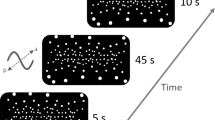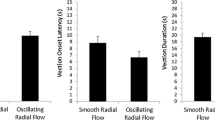Abstract
This study asked whether individual differences in the influence of vision on postural stability could be used to predict the strength of subsequently induced visual illusions of self-motion (vection). In the experiment, we first measured spontaneous postural sway while subjects stood erect for 60 s with their eyes both open and both closed. We then showed our subjects two types of self-motion display: radially expanding optic flow (simulating constant velocity forwards self-motion) and vertically oscillating radially expanding optic flow (simulating constant velocity forwards self-motion combined with vertical head oscillation). As expected, subjects swayed more with their eyes closed (compared to open) and experienced more compelling illusions of self-motion with vertically oscillating (as opposed to smooth) radial flow. The extent to which participants relied on vision for postural stability—measured as the ratio of sway with eyes closed compared to that with eyes open—was found to predict vection strength. However, this was only the case for displays representing smooth self-motion. It seems that for oscillating displays, other factors, such as visual–vestibular interactions, may be more important.




Similar content being viewed by others
Notes
Simultaneous measurement of vection and sway runs the risk that act of making the vection rating (whether it be verbal, button or joystick based) might introduce artefactual postural responses. In any event, there is a phase lag between the onset of visually induced postural sway and the subsequently reported onset of vection (see Kuno et al. 1999).
It should be noted that while these simulations were consistent with a 6 m/s forward self-motion through an environment that was 15 m wide × 15 m high × 40 m deep, they were also consistent with an unlimited number of other velocity/size combinations.
Spearman’s rho is robust to the influence of outliers, as it limits the contribution of each outlier simply to the value of its rank.
References
Apthorp, D., Stapley P, Palmisano S (2013) Individual variations in visual control of posture predict vection. Perception 42(ECVP abstract supplement):172
Berthoz A, Lacour M, Soechting JF, Vidal PP (1979) The role of vision in the control of posture during linear motion. Prog Brain Res 50:197–209
Howard IP (1982) Human visual orientation. Wiley, Chichester
Hufschmidt A, Dichgans J, Mauritz KH, Hufschmidt M (1980) Some methods and parameters of body sway quantification and their neurological application. Archiv Psychiatrie Nervenkrankh 228:135–150
Kelly JW, Riecke B, Loomis JM, Beall AC (2008) Visual control of posture in real and virtual environments. Percept Psychophys 70:158–165. doi:10.3758/PP.70.1.158
Kim J, Palmisano S (2008) Effects of active and passive viewpoint jitter on vection in depth. Brain Res Bull 77:335–342. doi:10.1016/j.brainresbull.2008.09.011
Kim J, Palmisano S, Bonato F (2012) Simulated angular head oscillation enhances vection in depth. Perception 41:402–414. doi:10.1068/p6919
Koslucher FC, Haaland EJ, Stoffregen TA (2014) Body load and the postural precursors of motion sickness. Gait Posture 39:606–610
Kuno S, Kawakita T, Kawakami O, Miyake Y, Watanabe S (1999) Postural adjustment response to depth direction moving patterns produced by virtual reality graphics. Jap J Physiol 49:417–424
Lacour M, Barthelemy J, Borel L, Magnan J, Xerri C, Chays A, Ouaknine M (1997) Sensory strategies in human postural control before and after unilateral vestibular neurotomy. Exp Brain Res 115:300–310
Lee DN, Lishman JR (1975) Visual proprioceptive control of stance. J Hum Mov Stud 1:87–95
Lestienne F, Soechting J, Berthoz A (1977) Postural readjustments Induced by linear motion of visual scenes. Exp Brain Res 28:363–384
Lishman JR, Lee DN (1973) The autonomy of visual kinaesthesis. Perception 2:287–294
Nakamura S (2010) Additional oscillation can facilitate visually induced self-motion perception: the effect of its coherence and amplitude gradient. Perception 39:320–329. doi:10.1068/p6534
Nakamura S (2013) Effects of additional visual oscillation on vection under voluntary eye movement conditions—retinal image motion is critical in vection facilitation. Perception 42:529–536. doi:10.1068/p7486
Palmisano S, Bonato F, Bubka A, Folder J (2007) Vertical Display Oscillation Increases Vection in Depth and Simulator Sickness. Aviat Space Environ Med 78:951–956. doi:10.3357/ASEM.2079.2007
Palmisano S, Allison RS, Pekin F (2008) Accelerating self-motion displays produce more compelling vection in depth. Perception 37:22–33. doi:10.1068/p5806
Palmisano S, Pinniger GJ, Ash A, Steele JR (2009) Effects of simulated viewpoint jitter on visually induced postural sway. Perception 38:442–453. doi:10.1068/p6159
Palmisano S, Allison RS, Kim J, Bonato F (2011) Simulated Viewpoint jitter shakes sensory conflict accounts of self-motion perception. Seeing Perceiving 24:173–200. doi:10.1163/187847511X570817
Palmisano S, Kim J, Freeman TCA (2012) Horizontal fixation point oscillation and simulated viewpoint oscillation both increase vection in depth. J Vis 12(12:15):1–14. doi:10.1167/12.12.15
Previc FH, Mullen TJ (1990) A comparison of the latencies of visually induced postural change and self-motion perception. J Vestib Res 1:317–323
Smart LJ, Stoffregen TA, Bardy BG (2002) Visually induced motion sickness predicted by postural instability. Hum Factors 44:451–465. doi:10.1518/0018720024497745
Stapley P, Beretta MV, Toffola ED, Schieppati M (2006) Neck muscle fatigue and postural control in patients with whiplash injury. Clin Neurophysiol 117:610–622. doi:10.1016/j.clinph.2005.11.007
Stoffregen TA (1985) Flow structure versus retinal location in the optical control of stance. J Exp Psychol Hum 11:554–565
Stoffregen TA, Smart LJ (1998) Postural instability precedes motion sickness. Brain Res Bull 47:437–448
Stoffregen TA, Hettinger LJ, Haas MW, Roe M, Smart LJ (2000) Postural instability and motion sickness in a fixed-base flight simulator. Hum Factors 42:458–469
Stoffregen TA, Yoshida K, Villard S, Scibora L, Bardy BG (2010) Stance width influences postural stability and motion sickness. Ecological Psychology 22:169–191 doi:10.1080/10407413.2010.496645
Tanahashi S, Ujike H, Kozawa R, Ukai K (2007) Effects of visually simulated roll motion on vection and postural stabilization. J Neuroeng Rehabil 4:1–11. doi:10.1186/1743-0003-4-39
Thurrell AEI, Bronstein AM (2002) Vection increases the magnitude and accuracy of visually evoked postural responses. Exp Brain Res 147:558–560. doi:10.1007/s00221-002-1296-1
Van Asten WNJC, Gielen CCAM, van der Gon JJD (1988) Postural adjustments induced by simulated motion of differently structured environments. Exp Brain Res 73:371–383
Van Parys JAP, Njiokiktjien CJ (1976) Romberg’s sign expressed in a quotient. Agressologie 17B:95–100
Villard SJ, Flanagan MB, Albanese GM, Stoffregen TA (2008) Postural instability and motion sickness in a virtual moving room. Hum Factors 50:332–345
Acknowledgments
This research was supported by an Australian Research Council Discovery Grant to SP (DP0772398).
Author information
Authors and Affiliations
Corresponding author
Rights and permissions
About this article
Cite this article
Palmisano, S., Apthorp, D., Seno, T. et al. Spontaneous postural sway predicts the strength of smooth vection. Exp Brain Res 232, 1185–1191 (2014). https://doi.org/10.1007/s00221-014-3835-y
Received:
Accepted:
Published:
Issue Date:
DOI: https://doi.org/10.1007/s00221-014-3835-y




